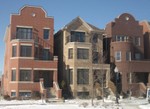 A few years ago, the Bridgeport Village subdivision was the lead horse on the team pulling forward the housing stock in Bridgeport, the onetime blue-collar South Side neighborhood that has given Chicago five of its mayors (including, of course, Richard M. Daley). Now a significant piece of the plan is on hold because the development has filed for bankruptcy protection.
A few years ago, the Bridgeport Village subdivision was the lead horse on the team pulling forward the housing stock in Bridgeport, the onetime blue-collar South Side neighborhood that has given Chicago five of its mayors (including, of course, Richard M. Daley). Now a significant piece of the plan is on hold because the development has filed for bankruptcy protection.
Back in 2004, big new brick houses, priced at $540,000 and up, were rising on several blocks along the east side of the Chicago River north of 35th Street. Developers planned to add many more houses-including more than 100 on the west side of the river-where they had bought nearly 14 acres of industrial land. They also envisioned one or two bridges that would span the river and link together the two parts of the development. To date, would-be homeowners have bought 102 houses in Bridgeport Village, all on the east side of the river.
But Bridgeport Village hit a rough patch in January 2005, when the city, alleging building-code violations, temporarily halted construction at the development. Work resumed later that summer, but it set off a rancorous dispute among Bridgeport Village’s three-man development team: Tom Snitzer on one side, and John Kinsella and Sid Diamond on the other. Kinsella and Diamond removed Snitzer as project manager in 2005, setting off a querulous blame game that includes back-and-forth allegations about mismanagement and political intrigue. (Citing court documents, the Chicago Tribune reported that Kinsella and Diamond charged Snitzer had left unpaid millions of dollars in bills related to the development; in an earlier lawsuit, wrote the Trib, Snitzer alleged that he was forced out of Bridgeport Village because he refused to pay kickbacks to well-connected political operatives.)
All this will be hashed out in U.S. Bankruptcy Court-and elsewhere-over the next few years. What is pertinent right now is that the project’s bankruptcy attorney, Steve Towbin, tells Deal Estate that all the land on the west side of the river is going to be sold off to cover some of development’s unpaid bills. “We’re going to sell it, that’s the plan,” says Towbin, of Shaw Gussis Fishman Glantz Wolfson and Towbin. “Residential is the way to maximize the value of that land, and it seems to me that whoever buys it is going to want to build residential.”
Towbin acknowledged that nothing is certain until a buyer is found, including whether the new owner will follow through on the original plan, bridges and all, or draw up its own layout. “It may or may not become formally a part of Bridgeport Village,” says Towbin.
Which means that pretty picture of neighborhood residents strolling along a slim footbridge over the river is stalled, and so is the plan to give people in the already-built houses on the east side of the river a cozy, leafy view of the west bank. The view of a truck garage and a cement batch plant that are there now will stay as is, at least until another developer who has in mind a cheery picture of the neighborhood comes along.


